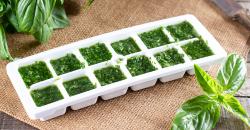Staying Safe – Play Safely in the Summer Heat
Recipes and Nutrition Tips – Family Meals and Roasted Corn Salsa
Physical Activity Tips – Outdoor Summer Fun
Gardening – Freezing Herbs for Future Use
Food Access Resources in Massachusetts – Summer Feeding Site
Staying Safe
 Be safe when playing outside in the summer heat.
Be safe when playing outside in the summer heat.
Take a summer vaction from your electronics and go outside to move your body in a neighborhood park or playground. Be aware that extreme heat and summer heat waves can cause heat-related illnesses like heat stroke, heat exhaustion, heat cramps, sunburn, and heat rash. Children, older adults, people who work outside, and people with disabilities are at the highest risk for heat-related illness.
Follow these tips to protect yourself and your family from heat-related illnesses:
- Don’t forget to bring your water to stay hydrated and snacks that travel safely and do not need refrigeration. Eat fruits and vegetables that have a high water content, such as bell peppers, celery, cucumbers, melons, peaches, and tomatoes. Avoid sugary beverages.
- Protect yourself from the sun with sunscreen, a hat, a shirt with long sleeves, and lightweight, light-colored long pants.
- Reduce the intensity of your outdoor activities during extremely hot days. Go for a walk in shaded areas and avoid midday peak hours in the sunlight.
Food Access Resources in Massachusetts
 School is out, free meals are in!
School is out, free meals are in!
The Summer Food Service Program, known as Summer Eats in Massachusetts, is a federally funded nutrition program that provides free meals to all kids and teens when school is not in session. Visit https://www.projectbread.org/summer-eats-program or call 1-800-645-8333 to find the summer meal sites near you.
Recipes and Nutrition Tips
 Stay connected and cook meals together.
Stay connected and cook meals together.
Try our Roasted Corn Salsa recipe and spice things up at your next family meal! Salsa dates back to the Aztec Empire and means “sauce” in Spanish. Premade salsas can be convenient but tend to be high in sodium. Eating too much sodium can lead to high blood pressure. Try our homemade salsa for less sodum and great taste! This salsa recipe is made with corn, a favorite summer vegetable. Roasting corn brings out its sweetness. The fresh tomatoes, onions, cilantro, and jalapeño pepper offer vitamin C, antioxidants, potassium, and flavor without added salt, sugar, or fat. These nutrients help our immune system, fight some types of cancer, and are important for heart health. Salsa can be used as a topping on burgers, grilled fish, or tacos. Mix it into your scrambled eggs or use as a dip with whole-grain chips. Whether you’re looking for a low-calorie condiment or a flavorful addition to your family meals, salsa is your answer. If you’re in a rush, use canned or frozen corn and look for packages with no salt or butter added.
Watch how the WVU Extension Service makes its salsa and homemade pita chips at https://youtu.be/6oOo3xDCPTU.
Physical Activity Tips
 Unwind with outdoor activities for the entire family.
Unwind with outdoor activities for the entire family.
It’s summertime and a great time to relax and have some fun! Most people look forward to summer because children are on break from school, the weather allows for outdoor activities, and the winter blues have been shaken off. Outdoor fun doesn’t have to cost much or take you too far from home. Visit your local dollar store to find items like balloons, pool noodles, bubble solution, and more to create fun games for the family. To let your imagination run wild with all the inexpensive ideas, visit Michigan State University’s backyard activities at https://www.canr.msu.edu/news/10_backyard_activities_to_do_with_children.
Gardening Tips
Fresh herbs are bountiful during the summer. If you enjoy using locally grown fresh herbs all year, want to save money, and don't want to waste herbs, freeze them! Follow the steps below to freeze your herbs in portioned amounts in ice-cube trays, making it easy to add to recipes later on.
- Before chopping your herbs, wash and dry them and remove any thick stems.
- Press the herbs into an ice-cube tray and fill each well with just enough water to completely cover the herbs.
- Freeze for 3 to 4 hours. Once frozen, pop each herb cube out of the tray and store in a freezer bag or airtight container labeled with the type of herb and date. For more information on preserving herbs, visit https://extension.umn.edu/ preserving-and-preparing/preserving-herbs-freezing-or-drying.
